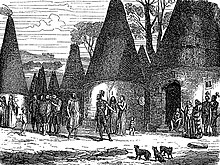User talk:Zoupan/Ethnogenesis of the Serbs
Overview[edit]
This section is empty. You can help by adding to it. |
Iron Age Balkans[edit]
This section is empty. You can help by adding to it. |
Early Slavs[edit]
This section is empty. You can help by adding to it. |

Christianization[edit]
This section is empty. You can help by adding to it. |

Amalgamation of Slavs and Romans[edit]
The Slavs, settling the Balkans in the 6th and 7th centuries, absorbed the Romanized populations over the centuries. Some Romance placenames survived Slavicization, such as the names of rivers and mountains. The Old Roman culture was preserved mainly in maritime Dalmatia, while Eastern, Greek influence and linguistics prevailed in the hinterland. The linguistical border roughly went from Alessio, below the Skadar–Prizren road towards Lipljan and Skopje, and then towards Sofia. The Roman element in the inlands retreated into the mountains with the Slavic incursions, however, larger areas of Roman elements were preserved in some parts of inland Balkans, such as in southern Macedonia and in Carpathian regions. Romance shepherd terminology were preserved in certain areas of the Dinaric Alps. The Slavs, due to their large numbers and abundance of reserves, easily assimilated the Roman population due to the deteriorating state of the Roman Empire. The Romans who had came to the Balkans as conquerors were defeated. The Serbs came under the Latin sphere of influence, and first came into contact with Christianity through these contacts. Serbs adopted many Latin terms, part of the vocabulary still today. With time, ties between the Slavs and Romans of the Balkans became more tighter, the larger numbered Slavs absorbing the largest part of the Roman population in the Western Balkans. The Vlach shepherds completely mixed with the Serbs, a result of the predominant pastoralist society and Christianity. Romans for long held themselves separately in the city municipalities on the coast, however, after the 10th century the Slavic inflow strengthened and subsequently the maritime cities had more or less Slavic character (such as Dubrovnik and Split, becoming holders of Slavic culture and literature in the 14th and 15th centuries). As anthropologist J. Erdeljanović noted, Serbs received cultural elements from the Vlachs, such as the stone house and cottage, parts of folk costumes, some shepherd terminology and likely some shepherding skills. Combinations of Slavic–Romance nomenclature were preserved in higher mountainous areas, and with the many migrations from the mountains into the lowlands northwards, most of the preserved old Balkan characteristics were merged into the general characteristics of all or larger parts of Serbs and Croats from the Adriatic and to the Timok river.[1]
Medieval Serbian states[edit]
This section is empty. You can help by adding to it. |
Early modern period[edit]
This section is empty. You can help by adding to it. |
See also[edit]
References[edit]
- ^ Ćorović 2001, ch. Балканска култура у доба сеобе Словена.
Sources[edit]
- Ćorović, Vladimir (2001) [1997]. "Балканска култура у доба сеобе Словена". Историја српског народа (in Serbian). Belgrade: Јанус.
{{cite book}}: Invalid|ref=harv(help) - John V. A. Fine; John Van Antwerp Fine (1994). The Late Medieval Balkans: A Critical Survey from the Late Twelfth Century to the Ottoman Conquest. University of Michigan Press. ISBN 0-472-08260-4.
- Janković, Đorđe. "The Slavs in the 6th century North Illyricum". Belgrade: Faculty of Philosophy.
- Novaković, Relja (1977). Odakle su Srbi došli na Balkansko poluostrvo. Istorijski institut.
- Novaković, Relja (1993). Srbi - ime Srbi kroz vreme i prostor. Istorijski institut.
- Novaković, Relja (2010) [1981]. "Gde se nalazila Srbija od VII do XII veka: Zaključak i rezime monografije" (Internet ed.).
{{cite web}}: Invalid|ref=harv(help) - Srejović, Dragoslav; Gavrilović, Slavko; Ćirković, Sima M. (1982). Istorija srpskog naroda: knj. Od najstarijih vremena do Maričke bitke (1371) (in Serbian). Srpska književna zadruga.
{{cite book}}: Invalid|ref=harv(help) - Živković, Tibor (2008). Forging unity: The South Slavs between East and West : 550-1150. The Institute of History.
{{cite book}}: Invalid|ref=harv(help) - Tibor Živković; Dejan Crnčević; Dejan Bulić (1 July 2013). The World of the Slavs : Studies of the East, West and South Slavs: Civitas, Oppidas, Villas and Archeological Evidence (7th to 11th Centuries AD). Istorijski institut. pp. 12–. ISBN 978-86-7743-104-4.
{{cite book}}: Unknown parameter|coauthors=ignored (|author=suggested) (help) - Dimitrije Bogdanović (1986) [1984]. "KNJIGA O KOSOVU". SANU.
- Sreten Petrović (1997). Mitologija Srba. Prosveta.
- Journals
- Tasić Nikola. "Some reflections on the migrations of palaeo-Balkan peoples in pre-roman times". Balcanica, 2014 (45):15-23.
- Markovich Slobodan G. "Patterns of national identity development among the Balkan orthodox Christians during the nineteenth century". Balcanica, 2013 (44):209-254.
- Mikić Živko M. "Anthropological traces of Slav presence in Kosovo and Metochia". Balcanica, 2005 (36):39-49.
- Zotović Radmila M. "Romanisation of the population of the eastern part of the Roman province of Dalmatia". Balcanica, 2003 (34):19-38.
- "Romanski uticaji na starosrpsku sintaksu" (PDF).
{{cite journal}}: Cite journal requires|journal=(help)
